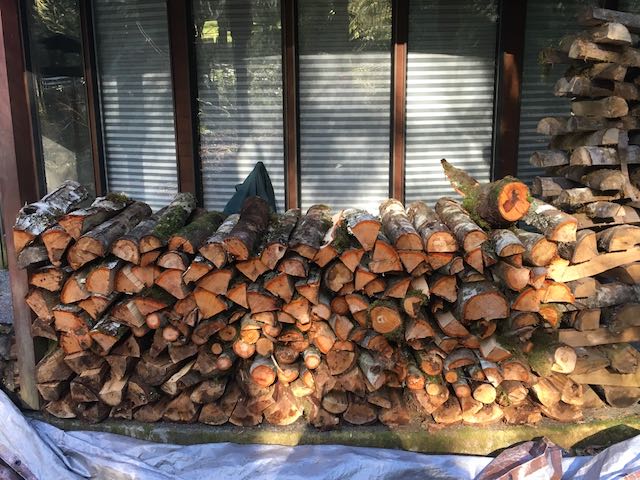
“Look!” I pointed out our study window, overlooking one of the five acres on which we live.
Cheryl, still asleep, or nearly so, could only mumble, “Mumpf?”
“A tree. A big one. It must have fallen recently. I didn’t hear it, but there it is…”
Trees fall frequently on our land. This alder crashed down during a windy rain which washed away a foot of snow, saturating ground already soft. Shallow roots lost their grip in the steep slope above the creek bordering our plot of Northwest woods.
Alders are weeds among the forest giants, the cedar, firs and hemlocks which surround us. Growing quickly, their shiny oval leaves quiver with the slightest stirring in the air. Thirty-some years ago, a plague of caterpillars infested our peninsula. Programmed to climb, they covered the bark of every alder, then branched out to decimate the leafy canopy. The soft incessant chewing sussurated like gentle rain. Many alders died that year, crashing down over the next decade, helping fill our wood pile for winter fires. The caterpillars appeared soon after the pollen storm which floats every March, showering the land with tiny alder seeds just before the leaves erupt. That year must have been propitious for renewal; most of the alders near us now, like this one which fell, are a foot and a half in diameter at the base, and present 33 rings when cut open.
I know this, because I counted them, hidden beneath the mossy bark, when I took my chain saw and began to methodically grind through the trunk sixteen inches at a time, the ideal size for our wood stove. Before I could dissect the alder, though, I had to work my way through its upper branches and those from a nearby maple which had blocked its descent.
We have never bought firewood since moving here in 1984, but every winter, we enjoy roasting, toasting by the stove on long and drizzly nights. Some years, enough trees fell to fill our wood pile. Others, I had to drop them myself. I don’t do that anymore, fearing I might lack the quickness to evade a wayward ton of lumber. Every tree I ever cut down fell exactly where I’d planned, but it’s not a record I want to test again.
Felling a tree to fall precisely is an art I taught myself, after reading and thinking it through. First, examine the natural lean. Going against the grain might result in the trunk dropping straight down, instead of at the preferred angle. Next, I look above for potential snags, branches or other trees still standing which could block or deflect. After choosing a drop zone, I cut a wedge from the trunk pointing towards that spot. The bottom should be horizontal, with another, upper cut down at angle, ending about one-third of the way through. Then, several inches above that wedge, on the opposite side, I start a horizontal cut. As the saw reaches the top of the wedge, the tree starts to crack and slowly shiver. That’s the time to look up and make sure it’s falling correctly, hit the dead-man switch, then quickly move in the opposite direction.
Once down, trimming the small branches takes little time. I’m left with stumps four inches in diameter to lop off into stove-size logs. Finally, a bare trunk remains. The ideal location for a fallen tree is on downward-sloping land. This allows the chunk being cut off to fall away from the main body, opening up the slit in which the saw proceeds. Even though my Makita chain saw is only fourteen inches long, I am able to cut through trees of two feet or more in diameter, by first arcing downward on the outside (away from me), then using the large teeth at the base of the saw to grip the wood, and continue straight down.
Now I have a large number of logs, most of them far too big to fit in the stove, or even to carry. I chop them into stove-sized pieces, another skill I had to learn. A heavy maul with an axe blade on one side is the best tool. Coupled with a four pound wedge, I’m able to split the wood to manageable size. The speed of the axe, the height from which I bring it – these are the subtle tools I use to minimize the work. I try to end up with logs of varying size, to aid the fire starting and maintenance process come winter.
At last, I load them into a wheelbarrow for a quick trip through our woods to the wood pile under the porch at the side of the house. Sometimes, I have to push the barrow uphill to get started, so placing its two legs on the flattest spot I can find is essential. Finally, I stack the logs, allowing for the newly exposed heartwood to air dry over summer.
Firewood warms you twice: once when you chop and stack it, then again when it burns.
